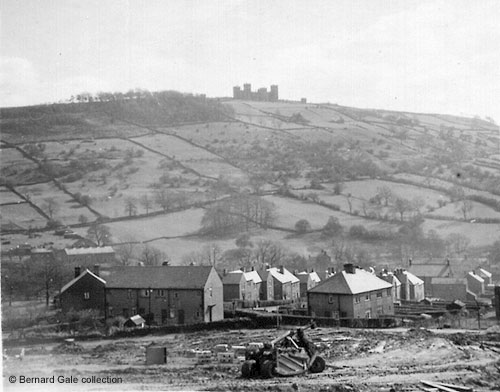|
Images Index> 20th & 21st Century, Matlock> This page |
| Lynholmes Road - or Hurst Farm Estate, Early Days |
| Matlock : Twentieth Century Photographs, Postcards, Engravings & Etchings |
|
|
||||||||||||
At a meeting of Matlock UDC in February 1948 the Council's Clerk, Mr. N. S. Brooks, "reported that the Ministry of Health had confirmed the Hurst Farm, Matlock, compulsory purchase order. The Hurst Farm Estate has been acquired for housing purposes and the lay-out provides for 499 houses, bungalows and shopping and community centres"[1]. A gentleman who worked for a short time for the Surveyor's department of Matlock UDC and dealt with the estate in 1951 has said that the estate was built around 1949/1950 by George Shipman and Company whom he believes were based in Belper. Lynholmes, where these photographs were taken from, had been built over twenty years before. Tenders for thirty houses at Lynholmes had been invited in June 1920[2]. Comparatively few of these houses were built[3]. The following year the Urban District Council were proposing to build 14 type C houses and 8 type B homes at Lynholmes[4]. In May 1925, at special meeting of the Matlocks Urban District Council with Mr. J. Shaw presiding, a letter was read from the Ministry of Health intimating that they approved of the suggestion of the council to grant assistance to private enterprise in house building, and also for the erection of 24 houses on the Lyn Holmes site by the Council, the subsidies to take the form of lump sum grants of £100. The development was for "working class houses"[5]. It was decided to appoint Mr. J. Simpson architect to the council scheme[6]. There were allotments on the site and in July the same year the holders were given notice to quit on 30 September so the Council could begin building[7]. Unfortunately, in 1925 after the Council had obtained permission from the Ministry of Health to build the 22 houses, the Ministry then refused to allow the work to continue as they believed the contract price was too high. Council officials then went to London and finally managed to get agreement, having agreed to minor modifications to a couple of the houses[3]. Charle White, the Liberal and then Labour Councillor, was amongst the earliest residents[7]. The field in front of the house in the top photograph belonged to an old character called Johnny Else who lived in an old farm house (Lime Tree House) where the shop opposite the Lindens, (formerly Nalgo House), was sited on Lime Tree Road. He used to have the local lads chopping logs for him and also haymaking in the field shown[9]. Below is a similar view, taken when the leaves were on the trees in about 1947. On the right you can see part of the Drill Hall on Lime Tree Road. The photograph was taken using a Kodak Box Brownie Camera that was made in the 1920s.
|
|||||||||||||
|
Both photographs and information kindly provided by and © Bernard Gale. Additional research, written by and © Ann Andrews. Intended for personal use only. |
|||||||||||||
References (coloured links are to transcripts elsewhere on this web site): [1] "Derby Daily Telegraph", 25 February 1948. [2] "Derbyshire Courier", 26 June 1920. [3] "Derbyshire Times", 10 October 1925. Ministry's Veto Raised. [4] "Derbyshire Times", 18 June, 1921. Housing Scheme. [5] "Derby Daily Telegraph", 26 May 1925. [6] Letterheads of Local Businesses, 1900-1949 (5) - Mr. Simpson's Letter headings. [7] "Derby Daily Telegraph", 14 July 1925. [9] The Else family were at Lime Tree Lane and/or Lime Tree House in the 1871 census | the 1881 census | the 1891 census | the 1901 census. Ann Else, John Else's mother, can also be found farming at Lime Tree House in Kelly's 1876 Directory | Kelly's 1891 Directory | Kelly's 1895 Directory | Kelly's 1899 Directory | Kelly's 1908 Directory. His sister advertised in Kelly's Directory 1912 | Kelly's Directory 1916. A young Johnny Else can be found on Matlock: Coup - Else Marriage at St. Giles', 1890 and Matlock Bath: Else & Marsh Wedding, Glenorchy Chapel, 1915. John Else and his elder brother William were still living at Lime Tree House Farm/House in 1939 (from the 1939 Register). [8] The first time his name has been found living at Lynholmes was in a report in the "Ashbourne Telegraph", 10 May 1929 when he stood for Hanley. He was already a member of Matlock UDC and a Derbyshire County Councillor. [9] With thanks to Susan Tomlinson for
finding the photos mentioned. The "Derbyshire Advertiser
and Journal" of 5 March 1915 describes the arrival of
the 2nd W. Yorkshires on a day of bitter wind, hail and sleet.
The "Harrogate Herald" of 10 March 1915 names a
Yorkshire lad, a private in the 5th Yorkshires, who was based in Matlock. |





